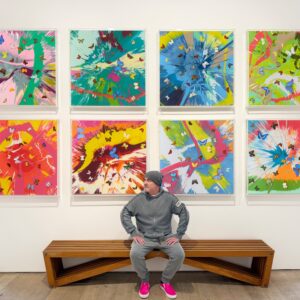In Against Nature, the architect Sam Jacob presents altered images of prehistoric monuments and landscapes, plus a chandelier and a bean bag.


The show is one of extraordinary visions that take us on a visual and conceptual excursion across time and the land. On one side of the main Betts Project gallery in London is a new series called Ritual Litter in which Jacob has used antiquarian prints of dolmen, the structures built in neolithic times in which a burial chamber lies under a capstone supported by standing stones. Jazzy, brightly-coloured acrylic geometric shapes transform and dynamise the images, and demand up-close scrutiny. On the opposite wall is an array of landscape paintings acquired on eBay, into which Jacob has inserted ominous black triangles, squares and rectangles. This new series is called Against Nature, and you don’t need to stand close to be struck by their weird ambiguous power.

What’s this all about? I asked Jacob if the show’s title was an eco-message, since humanity’s impact against nature is creating such global disaster. ‘I suppose yes’, he replied, ‘but in a longer way’. In fact, there are two narratives which the show explores, both longer in terms of time and territory. One is how what we think about prehistoric stone constructions changes with time, and the other addresses the fake versions of nature that landscape architecture generates.

Jacob likes to spend holidays in places like Cornwall, a place littered with neolithic monuments, so let’s start with them. As well as the Ritual Litter series, a circular chandelier called A Perfect Zero floats above the gallery like a great halo, with a line of neon shaped to represent the outer ring of Stonehenge’s great stones. ‘Neon being signage, it becomes a sign’, Jacob comments. Many suspects have been fingered as the creators of Stonehenge, including giants, the magician Merlin and the Romans, and its purpose has been imagined as religious, a place of celebration and an astronomical calculator. Jacob has orientated A Perfect Zero exactly like the monument which aligns with sunrises on the equinoxes. The folklore and interpretation that Stonehenge’s mystery has spawned shows just how our ideas change with the times.

So too with other neolithic stones. On the floor is a crumpled beanbag that is printed to look like an ancient stone, following a digital scan of a roadside neolithic stone in Swindon which has been reputed to cross the road at night. As for the dolmen tomb structures, they are architecture that has survived many millennia. Architecture is against nature because it is artificial, containing or configuring un-natural space. The dolmen stand physically adjacent, or against, nature. Although their distribution is global — over a third of all dolmen are actually in Korea — Jacob’s works show English and Welsh ones, as drawn in the 18th and 19th centuries. A personal favourite of his is Druidical Circles at Stanton Drew, Somerset, using a print from the Illustrated London News in 1864, to which his acrylic interventions add new floating and supporting elements. Stones that make dolmen have an abstract quality, and so do Jacob’s new shapes. Sometimes, as for example in Druids Temple in the Island of Jersey, you see a floating red circle not unlike the Russian constructivist architect Ivan Leonidov may have added to one of his late-period paintings. You could even say that the hybrid old/new dolmen that Jacob represents become post-constructivist structures, and indeed in Shenzhen, he has actually built a new architectural example called Yantian Dolmen (2020), a shelter standing on an otherwise anodyne street corner. But in Ritual Litter, it is the interplay between his interventions and the past that is the focus, and the result is fascinating and magical.

The Against Nature series of paintings follow from his 2017 series Blind Spot, in which Jacob intervened with black shapes on landscape paintings by (then) Prince Charles, who’s famously not keen on modern architecture and has an idealised view of traditional Britain, including landscape. In great country estates, landscape itself has been physically ‘improved’ by landscape architects ever since Capability Brown in the 18th century. The paintings that Jacob has intervened in — the largest over a metre wide — are mainly landscapes from nowhere in particular (and a couple of seascapes), mainly in the original painters’ imagination, and they vary in style from faux-Turner or faux-Claude atmospheric nineteenth-century works to contemporary fantasies in lurid colours. ‘They’re all paintings from the picturesque tradition of landscape gardens’ says Jacob, adding that the ‘black shapes are to do with the flatness of the object’. Black squares may prompt thoughts of Malevich’s, but the monoliths in Kubrick’s 2001: A Space Odyssey are a closer comparison, because the new shapes are also mute, flat and alien in the place where they’ve unaccountably arrived. Jacob’s works highlight the ambiguity between the spatial and the representational, and makes a contrast that is as stark as you get. The effect is so strong, you simply can’t unsee these works.

Perhaps it takes an architect to reveal something we don’t see in our ever-evolving (and now-desperate) relationship with nature, because architecture, like ideas about our world, is an artificial construct. Jacob’s revelations span deep time, and like magic, are delivered with the wizardry of a contemporary Merlin.
Sam Jacob Against Nature – to April 15th, Betts Project London
About the artist
Sam Jacob is principal of Sam Jacob Studio for architecture and design. He has been professor of architecture at University of Illinois at Chicago since 2011 and has taught at international institutions including the Architectural Association, London where he is a member of the governing council. His studio’s recent built projects include the V&A’s first international gallery in Shenzhen, the new home Cartoon Museum London, the V&A’s Cromwell Road entrance, and the National Collections Centre for the Science Museum Group. Jacob was previously he was a founding director of FAT Architecture.
His curation and exhibition design projects include the Science Museum, the Design Museum, The V&A, Design Society, The RIBA Architecture Gallery, Schunck, Somerset House and MK Gallery. Jacob’s solo exhibitions include Disappear Here at the RIBA Gallery (2018) and Empire of Ice Cream at Betts Project (2019).Jacob has contributed to the Venice Architecture Biennale in 2016, 2014 (where, as part of FAT he was co-curator of the British Pavilion) and 2012, Pattern as Politics at the Lisbon Architecture Triennale 2019 (with Priya Khanchandani) and the Chicago Architecture Biennial (2017).




